» posted on Friday, July 1st, 2022 by Linda Lou Burton
Deja Re-View
No Mask Needed This Way, July 1, 2020
Originally published July 1, 2020 by Linda Lou Burton posting from Little Rock, Arkansas – I had a friend who had 366 notebooks lining the shelves of his office, labeled with each day of the year, yes, even including Leap. Every day he added a new page in the proper notebook . He could tell you exactly what he was doing, and thinking, and feeling, on any day as far back as twenty years.
On February 29 of this Leap Year, I got news of the first case of the COVID-19 virus in the United States. I was standing in the arena at the fairgrounds here in Little Rock, attending the state Flower & Garden Show with a friend. She was checking her phone for messages, and the news popped up. “Where?” I asked. I’d spent the last month booking reservations for my Round The World trip in July that would take me to the last two continents on my list of seven – Australia and Asia. I had scrupulously avoided China in the plan, due to rumblings of a highly contagious disease and contaminated cruise ships there.
When she told me the case was in Seattle, I was not only startled, but genuinely alarmed, as it was precisely in the area where two of my sons live, with their families. Six grandchildren there! And, Seattle was to be the first stop on the Journey Round The World. My flight was booked for July 7.
“Oh, it will all be done by May,” was the line on everybody’s lips. “Don’t worry.”
I have been tracking the numbers since March 1. As of today 2,624,873 cases have been reported in the United States and its territories by the Centers for Disease Control; with 127,299 deaths from the disease. The only “US soil” that has remained virus-free is American Samoa, which was to be a major stop on my RTW.
There were several kinds of things the RTW would tick off my list of “things to do before I die” (aka Bucket List). I could claim all seven continents as mine; and all five oceans. I would visit the southernmost and northernmost capital cities in the world – Wellington, New Zealand and Reykjavik, Iceland. I would cruise the longest rivers on the continents of Australia and Africa – the Murray and the Nile. I would visit two wonders of the world – Ayers Rock or Uluru, the giant red monolith in the heart of Australia; and the Sphinx and the Pyramids of Giza in Egypt. I would visit three far-flung US National Parks – Haleakala and Hawaii Volcanoes in Hawaii; American Samoa in – well, American Samoa. And best of all, I would add nine world capital cities to my Capital City list! With the added bonus of having my two youngest grandchildren join me in Reykjavik as a “high school graduation gift,” with my RTW ending in Washington, DC with grandkids, in an election year!
This trip would be a crown in my crowns. The grandkids, Kayla and Sam, had been a part of the Journey Across America in 2012; Kayla to Honolulu with me; Sam to Juneau. Now those 4th graders are done with high school! And what a (excuse the language please) SUCKY senior year they were served; schools were closed in March so no senior prom, no bonding with friends, just a Virtual Do and, that’s it. Also, sadly, no trip to Reykjavik, and Washington, DC.
I am now 81 years old, and although the airlines have offered “rebooking” opportunities in years to come, I don’t plan to travel worldwide until the word “pandemic” is erased from our daily conversation and the (currently non-existent) vaccine is keeping everyone, all over the world, SAFE from COVID-19.
So, here’s the deal. I’ll do my traveling VIRTUALLY, and tell you all about it. Plus, I’ll review and update the 51 wonderful capitals I visited on the Journey Across America. I’ve always believed the best thing about travel is the memories; they never RUST or wear out. They nurture you when you are “too old to rock the rocking chair.” (And I am getting close to that.)
On July 1, 2012, I had just returned from Honolulu with Kayla, and was settling in for a two-week stint in Olympia, the capital city of Washington. It was a cool, gray day, as my cats Alex and Jack settled in with me in a peaceful spot.
On July 1, 2013, I was in Des Moines, the capital city of Iowa, where one expected the corn to be “knee high by the 4th of July.” I learned a lot about pigs there too, and genuine Midwestern friendliness.
Today, July 1, 2020, I live in Little Rock, the capital city of Arkansas, with my Katy cat, where Social Distancing is now the required norm, and face masks the recommended attire.
Still in love with capital cities. Still enjoying the world we live in.
Go with me? You won’t even need a face mask!
Knee High By The 4th of July, July 1, 2013
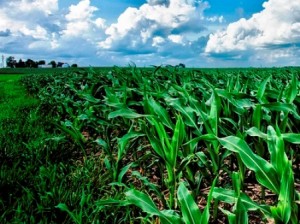 Linda Burton posting from Des Moines, Iowa – “Oh What A Beautiful Morning!” Remember that Rodgers & Hammerstein tune from Oklahoma? Driving through the Iowa countryside a few days ago, with early summer cornfields rolling across the hills to my right and to my left, I thought of a line from that song “….the corn is as high as an elephants eye….” Then I laughed, because the corn I saw was just beginning to get a grip on growing; it’s pretty darned early in the season here. “That corn is only knee high,” I thought. Later I learned that’s the catch-phrase of corn farmers: “We look for the corn to be knee high by the 4th of July,” I was told. That’s the
Linda Burton posting from Des Moines, Iowa – “Oh What A Beautiful Morning!” Remember that Rodgers & Hammerstein tune from Oklahoma? Driving through the Iowa countryside a few days ago, with early summer cornfields rolling across the hills to my right and to my left, I thought of a line from that song “….the corn is as high as an elephants eye….” Then I laughed, because the corn I saw was just beginning to get a grip on growing; it’s pretty darned early in the season here. “That corn is only knee high,” I thought. Later I learned that’s the catch-phrase of corn farmers: “We look for the corn to be knee high by the 4th of July,” I was told. That’s the 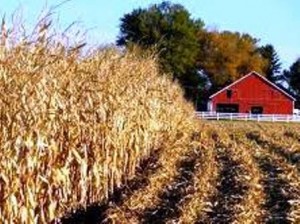 assurance that everything is on track; “elephant’s eye” corn isn’t expected until late September; most harvesting happens in October and sometimes into November. Then there’s a lot of harvesting going on; in 2012 Iowa corn farmers grew almost 1.88 billion bushels of corn, on 13.7 million acres of land; 2013 projections indicate 2.45 billion bushels on 13.97 million acres. Iowa has produced the largest corn crop of any state for more than two decades; in an average year, Iowa produces more corn than most countries! And it’s been the dominant
assurance that everything is on track; “elephant’s eye” corn isn’t expected until late September; most harvesting happens in October and sometimes into November. Then there’s a lot of harvesting going on; in 2012 Iowa corn farmers grew almost 1.88 billion bushels of corn, on 13.7 million acres of land; 2013 projections indicate 2.45 billion bushels on 13.97 million acres. Iowa has produced the largest corn crop of any state for more than two decades; in an average year, Iowa produces more corn than most countries! And it’s been the dominant 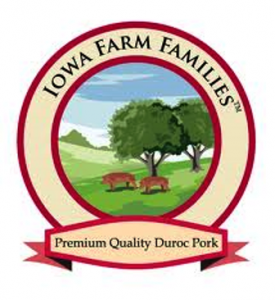 crop in Iowa for more than 150 years. The reasons are simple – a growing season that is long enough and warm enough, ample rain, and deep, rich soil. Iowa also produces livestock whose waste includes nutrients that are key to fertilizing the fields for better corn production. According to Iowa Agriculture farm statistics, in 2012 there were 195,000 sheep and lambs on hand, 3.9 million cattle and calves, and 20 million hogs. And, by the way, Iowa is the number one pork producing state in the country too.
crop in Iowa for more than 150 years. The reasons are simple – a growing season that is long enough and warm enough, ample rain, and deep, rich soil. Iowa also produces livestock whose waste includes nutrients that are key to fertilizing the fields for better corn production. According to Iowa Agriculture farm statistics, in 2012 there were 195,000 sheep and lambs on hand, 3.9 million cattle and calves, and 20 million hogs. And, by the way, Iowa is the number one pork producing state in the country too.
I went to the Iowa Agriculture website for some basic farm facts; I wanted to know how many farms there are in Iowa, overall. The answer (as of 2011) is 92,300 farms, covering 30.7 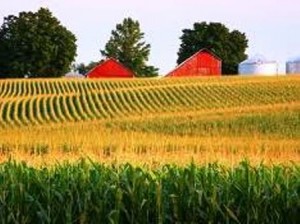 million acres of the state. The size of an average farm is 333 acres, valued at about $6,708 per acre. That long growing season I mentioned has temperatures ranging from an average of 13.2F in January to 75.3F in July, with an average annual rainfall of 45.10 inches. Soybeans, milk, and eggs are other biggies in the state; 466 million bushels of soybeans grown on 9.23 million acres in 2011; 4.33 billion pounds of milk produced; 14.5 billion eggs. Equate that to how many glasses of milk you drink in a week, or how many sunny-side-up breakfasts you enjoy. As to the bacon that accompanies those breakfast eggs – I pulled some numbers from the National Pork Board and the US Census of Agriculture. Iowa has about 8,300 hog operations; more than 39,000 jobs are directly related to raising and caring for hogs in Iowa; the industry generates nearly $950 million in household income for pork producers.
million acres of the state. The size of an average farm is 333 acres, valued at about $6,708 per acre. That long growing season I mentioned has temperatures ranging from an average of 13.2F in January to 75.3F in July, with an average annual rainfall of 45.10 inches. Soybeans, milk, and eggs are other biggies in the state; 466 million bushels of soybeans grown on 9.23 million acres in 2011; 4.33 billion pounds of milk produced; 14.5 billion eggs. Equate that to how many glasses of milk you drink in a week, or how many sunny-side-up breakfasts you enjoy. As to the bacon that accompanies those breakfast eggs – I pulled some numbers from the National Pork Board and the US Census of Agriculture. Iowa has about 8,300 hog operations; more than 39,000 jobs are directly related to raising and caring for hogs in Iowa; the industry generates nearly $950 million in household income for pork producers.
Enough with the numbers; I wanted to know what kind of hogs are raised, and what is different about each breed. But first a little Pig Latin Lesson: “boars” are males of breeding  age; “sows” are breeding females; and “piglets” need no explanation; they are the unweaned little ones.
age; “sows” are breeding females; and “piglets” need no explanation; they are the unweaned little ones.
From the Des Moines National Pork Board website, which also has delicious recipes for the use of pork, I learned that most hogs bred for consumption are the offspring of a combination of breeds – usually dark-breed boars bred to white-breed sows. Dark breed boars enhance meat quality; white-breed sows produce many piglets, plus their maternal instincts allow more piglets to survive. A producer will choose a particular breed, or combination of genetic lines, based on what they are looking for with regard to meat quality, farming method, and the hog market. Here are eight of the most widely popular.
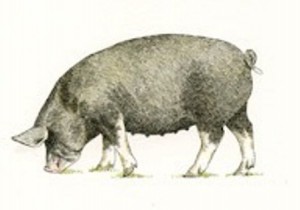 Berkshire. A black pig that originated in Britain in the mid-1500s, prized for juiciness, flavor, and tenderness, yielding a pink-hued, heavily marbled meat suitable for long cooking times.
Berkshire. A black pig that originated in Britain in the mid-1500s, prized for juiciness, flavor, and tenderness, yielding a pink-hued, heavily marbled meat suitable for long cooking times.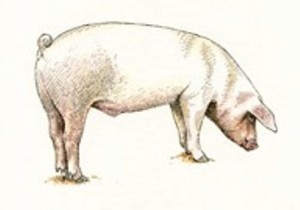 Chester White. Used in commercial crossbreeding; originated in Pennsylvania in the early 1800s when white pigs common to the northeast US were bred with a white boar imported from Bedfordshire, England.
Chester White. Used in commercial crossbreeding; originated in Pennsylvania in the early 1800s when white pigs common to the northeast US were bred with a white boar imported from Bedfordshire, England. Duroc. Known for quick growth; red or black coloring; the second most recorded breed in the US; a main sire choice of American farmers. Sweet meat, amazing shoulders and spareribs.
Duroc. Known for quick growth; red or black coloring; the second most recorded breed in the US; a main sire choice of American farmers. Sweet meat, amazing shoulders and spareribs. Hampshire. Fourth most recorded breed in America and oldest American breed in existence; stock imported from Wessex, England in 1832. Black with a white belt across the shoulders, a lean-meat breed.
Hampshire. Fourth most recorded breed in America and oldest American breed in existence; stock imported from Wessex, England in 1832. Black with a white belt across the shoulders, a lean-meat breed.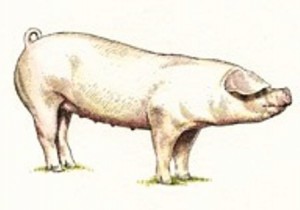 Landrace. Fifth most recorded breed in the US; known for large litters of piglets. A white pig, descended from the Danish Landrace; produces a large and flavorful ham and loin.
Landrace. Fifth most recorded breed in the US; known for large litters of piglets. A white pig, descended from the Danish Landrace; produces a large and flavorful ham and loin.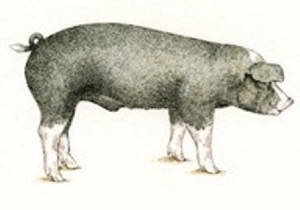 Poland China. Black with white face and feet, derives from many breeds, including the Berkshire and the Hampshire. Known for large size; one of the most common breeds in the US.
Poland China. Black with white face and feet, derives from many breeds, including the Berkshire and the Hampshire. Known for large size; one of the most common breeds in the US. Spotted Pig. Black and white spots, no red or brown; popular in the US because of high meat quality and ability to gain weight quickly.
Spotted Pig. Black and white spots, no red or brown; popular in the US because of high meat quality and ability to gain weight quickly.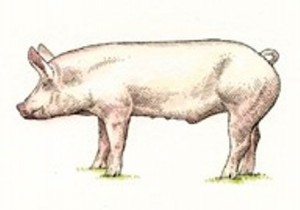 Yorkshire. #1 recorded breed in the US; white, very durable and muscular, high proportion of lean meat. Developed in the county of York, England, and brought to the US around 1830.
Yorkshire. #1 recorded breed in the US; white, very durable and muscular, high proportion of lean meat. Developed in the county of York, England, and brought to the US around 1830.
Now that you’re up on pigs, let’s get back to corn. Because, you see, most Iowa corn goes into animal feed. One bushel of corn converts to about 13 pounds of retail pork. Iowa’s corn is 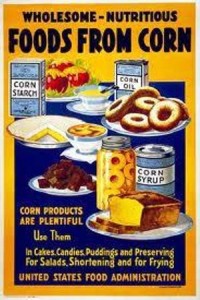 also processed into starches, oil, sweeteners, and ethanol. Most of the corn you see growing in fields across Iowa is field corn, not the sweet corn-on-the-cob you think about for summer cookouts, dripping with butter. The sweet corn that is grown in Iowa is usually sold at farmers’ markets and roadside stands, not shipped out of state, so if you live in Arizona or Vermont, you’ll likely never see Iowa corn in your supermarket. But it will be in products you use – the Corn Refiners Association has conducted surveys tallying all supermarket products that contain corn ingredients and come up with the staggering number of at least 4,000. Read your labels! Corn is nearly everywhere – even used in paper products.
also processed into starches, oil, sweeteners, and ethanol. Most of the corn you see growing in fields across Iowa is field corn, not the sweet corn-on-the-cob you think about for summer cookouts, dripping with butter. The sweet corn that is grown in Iowa is usually sold at farmers’ markets and roadside stands, not shipped out of state, so if you live in Arizona or Vermont, you’ll likely never see Iowa corn in your supermarket. But it will be in products you use – the Corn Refiners Association has conducted surveys tallying all supermarket products that contain corn ingredients and come up with the staggering number of at least 4,000. Read your labels! Corn is nearly everywhere – even used in paper products.
And corn grows nearly everywhere; you’ll find it on every continent except Antarctica. It is descended from a plant called teosinte, which still grows in Mexico; the first corn plants seem to have appeared in Mexico. Millenniums of breeding, first by Native Americans, then by 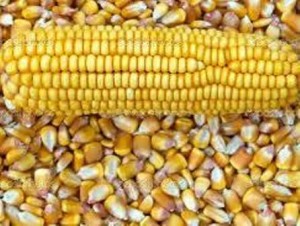 early pilgrims and modern scientists, have resulted in larger, fuller ears, and made corn one of the world’s three leading grain crops (rice and wheat are the others). Much of Iowa’s field corn is bred to develop just one large ear rather than several incomplete ears; the number of kernels per ear vary from 500 to 1,200, but a typical ear has about 800 kernels. A bushel of shelled corn (after husks and cobs are removed) weighs about 56 pounds and last year Iowa corn growers harvested an average of 172 bushels per acre of land (the national average was 147). To further visualize, an acre is about the size of a standard football field.
early pilgrims and modern scientists, have resulted in larger, fuller ears, and made corn one of the world’s three leading grain crops (rice and wheat are the others). Much of Iowa’s field corn is bred to develop just one large ear rather than several incomplete ears; the number of kernels per ear vary from 500 to 1,200, but a typical ear has about 800 kernels. A bushel of shelled corn (after husks and cobs are removed) weighs about 56 pounds and last year Iowa corn growers harvested an average of 172 bushels per acre of land (the national average was 147). To further visualize, an acre is about the size of a standard football field.
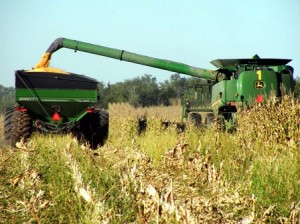 About those husks and cobs – when corn is harvested the combine strips the husks off each ear and removes the kernels; the kernels are stored in a holding tank until they can be unloaded into a truck. But the husks and cobs are spread back into the field as the combine moves along; it’s just like mulch in your home garden. Good soil fertility is there for the next crop; corn plants that will grow up to 12 feet tall, just about as high, I’m thinking, as an elephant’s eye.
About those husks and cobs – when corn is harvested the combine strips the husks off each ear and removes the kernels; the kernels are stored in a holding tank until they can be unloaded into a truck. But the husks and cobs are spread back into the field as the combine moves along; it’s just like mulch in your home garden. Good soil fertility is there for the next crop; corn plants that will grow up to 12 feet tall, just about as high, I’m thinking, as an elephant’s eye.
Sunday Morning Coming Down, July 1, 2012
 Linda Burton posting from Olympia, Washington – The joke is “summer doesn’t arrive in the Pacific Northwest until after the 4th of July” but it’s no joke. In 1987 I dried out in front of a blazing fire after giving up on the soggy Seattle fireworks display and coming home sopping wet and shivering. It looks as though this year will follow that pattern; it was raining when I woke up; a Sunday morning gray. A cat snuggled tight against either side of me; I guess I’m forgiven for taking off for Hawaii and leaving them behind. I opened up the Fancy Feast and then slept two hours more. Under the blanket and the pile of cats it was cozy and warm, but checkout time loomed close; time to load the car, drive to Olympia, unload everything, settle in for the next two-week stint. I was misty-soaked and feeling blue in all the gray, my body temp still set on Hawaiian warm. Just drive, I told myself.
Linda Burton posting from Olympia, Washington – The joke is “summer doesn’t arrive in the Pacific Northwest until after the 4th of July” but it’s no joke. In 1987 I dried out in front of a blazing fire after giving up on the soggy Seattle fireworks display and coming home sopping wet and shivering. It looks as though this year will follow that pattern; it was raining when I woke up; a Sunday morning gray. A cat snuggled tight against either side of me; I guess I’m forgiven for taking off for Hawaii and leaving them behind. I opened up the Fancy Feast and then slept two hours more. Under the blanket and the pile of cats it was cozy and warm, but checkout time loomed close; time to load the car, drive to Olympia, unload everything, settle in for the next two-week stint. I was misty-soaked and feeling blue in all the gray, my body temp still set on Hawaiian warm. Just drive, I told myself.
It’s a mess, I-5 I mean; and the speed limit is 60 all the way; what’s that about? The Girl Scout motto learned so many years ago forgot, I put no water for the kitties in the back; didn’t fill the litter box; it was a short drive to Olympia.  And so you see, I was not prepared for the rooms reserved weeks ago to be refused to me. A chain I often used, this one did not accept cats; my “Pet Friendly” filter somehow slipped. (Big expose some day, about the inconsistencies of chains, and the unkindnesses to pets!) They refused me gently though, and called to find a room for me. A downtown highrise, not my favorite choice, but decision-making time was running short (no water, and no litter box).
And so you see, I was not prepared for the rooms reserved weeks ago to be refused to me. A chain I often used, this one did not accept cats; my “Pet Friendly” filter somehow slipped. (Big expose some day, about the inconsistencies of chains, and the unkindnesses to pets!) They refused me gently though, and called to find a room for me. A downtown highrise, not my favorite choice, but decision-making time was running short (no water, and no litter box).
My reaction was muted by the gray; okay, I’ll take the room. It wasn’t ready yet, please sort it out, I begged. Housekeeper beeped another floor, got somebody on it, quick. “Start your unload,” she soothed, “and bring those kitties in.” She described her long-haired cat, her love of 15 years, “I want to meet your Jack,” she smiled, “and Alex too.” I warmed from blue to pink. Four loads with the rattley cart; four floors on the elevator; and then, we’re home and all is well. Let’s watch the evening news, and catch up with the rest of the world.
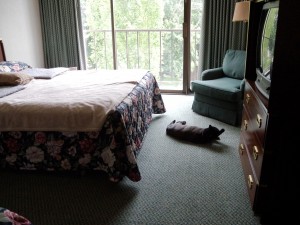 It’s pleasant here. No doubt that things would turn out fine; I’ve got the Bubble over me. Dig through the suitcase for warmer clothes, zip the black sweater clear up to my neck, pull on some socks. It was 109 in Nashville today, the Brian Williams Sunday-substitute is telling on the news, and power’s out all in the stormy east. But I am safe, here at the end of Puget Sound, looking forward to the peace, and quiet, and gentle soothing gray; an easy place to be.
It’s pleasant here. No doubt that things would turn out fine; I’ve got the Bubble over me. Dig through the suitcase for warmer clothes, zip the black sweater clear up to my neck, pull on some socks. It was 109 in Nashville today, the Brian Williams Sunday-substitute is telling on the news, and power’s out all in the stormy east. But I am safe, here at the end of Puget Sound, looking forward to the peace, and quiet, and gentle soothing gray; an easy place to be.
